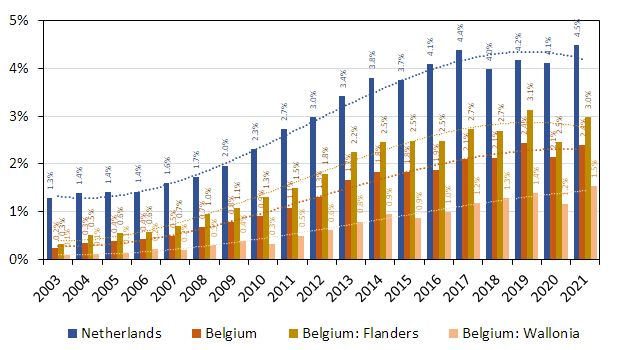Dutch and Belgian VAD rates have levelled off

Through the lens of Covid lock-downs, six years ago seems like an eternity ago, doesn't it? But it was back in 2016 that I published a major analysis of voluntary assisted dying rates and practice in the Benelux lowlands, focusing a bright spotlight on the Netherlands and Belgium.
Using authoritative and robust data, I indicated that the ongoing rise in both countries' VAD rates would level out at rates that were culturally bound. This despite persistent hyperventilations of VAD opponents that most of us would eventually be "knocked off" by not-so-voluntary euthanasia. Generally, the adoption of behaviours at the societal level tends to follow a sigmoidal (stretched S-shaped) curve, and the then VAD data was consistent with this phenomenon.
The above chart is data I presented in 2016, with third order polynomial fits. A few things worth noting:
- Both countries' VAD legislation came into effect in 2002.
- Their legislation is quite similar, with only small differences.
- Belgium provides a microcosm of cultural analysis because the national legislation applies to both the Dutch-predominant north (Flanders) and the French-predominant south (Wallonia).
- The Dutch data starts well above zero because it had permitted VAD by regulation (not legislation) for some two decades prior to the legislation.
- The late drop in the Dutch trend line is not so much a prediction, but a mathematical curiosity of third order polynomials. I did not predict a drop after leveling off.
- The separate data for Flanders and Wallonia is measured by the proxy indicator, language (VAD reports filed in Dutch versus French). This is not perfect, particularly since Brussels, counted by the Belgians as a third official and separate region, speaks mostly French but is situated in Flanders. Nevertheless, it provides a powerful indicator of cultural differences in practice under the same laws.
In March last year the Belgian euthanasia commission published its 2020 report card. I re-analysed the data and wrote that the Netherlands' natural VAD rate seemed to be around 4.3%, and Belgium's (nationally) around 2.4%.
In April last year, the Dutch euthanasia commission published its 2020 report card. I analysed the data again and wrote that due to increased total deaths in 2020 due to Covid-19, the seeming drop in the VAD rates was an aberration and the rates would likely be slightly higher for 2021. This proved to be correct.
The very latest data
The other day, the Belgium euthanasia commission published a brief report of the statistics for 2021, and the Dutch euthanasia commission had also published its 2021 report card. So I thought this was an excellent opportunity to update our knowledge about culture and VAD rates.
And here's the same chart as above, updated with all data up to 2021.
 Dutch and Belgian VAD rate analysis as at 2022
Dutch and Belgian VAD rate analysis as at 2022
The Dutch VAD rate indeed has levelled out at around 4.3%, and the Belgian rate at around 2.4%. The Dutch rate is quite close to the prediction of 2016, while the Belgian rate is actually a bit lower than the 2016 prediction.
And the cultural difference between Dutch and French-speaking Belgians continues, with the Belgian Dutch VAD rate higher and closer to the Netherlands (of course, Dutch) rate. And the French-speaking rate seems not to have quite reached its resting place yet. That might well take another five or more years.
So, here's another general prediction. There will be further rises in the VAD rate, but they will be small, and long-term. This is because a majority of VAD occurs in relation to cancer, and cancer, statistically speaking, makes an appearance in the 50s age bracket, and peaks in the 60s and 70s. And populations in these countries, as around the world, are ageing.
But at no stage was hyperventilation warranted that significant numbers of people would be pressured into VAD, because there was a period of cultural "settling" in regard to both a personal preference for VAD in response to extreme and unrelievable suffering, and accessibility of VAD.
